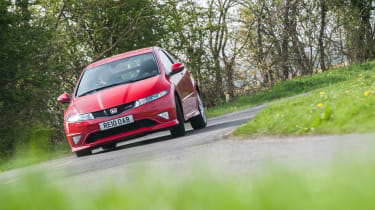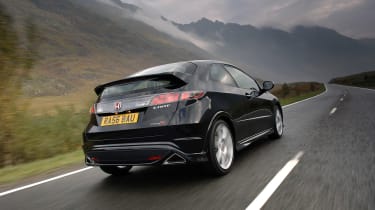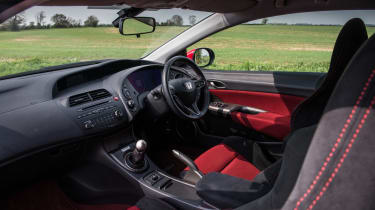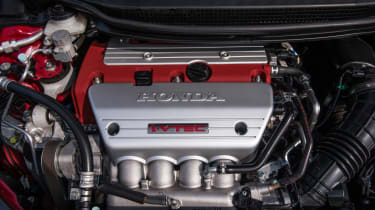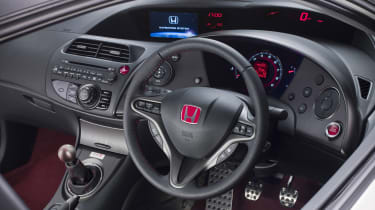Used Honda Civic Type R (FN2, 2007 - 2011) review and specs
Earlier Type Rs are more beloved and later ones faster, but the last naturally aspirated Type R is now the most affordable
The UK market never received the original EK9 Honda Civic Type R, but we’ve been lucky enough to make the list for each generation of hot Civic launched since. The most recent, sixth-generation car (the FL5) is a class-defining hot hatchback, pairing huge performance with a chassis that’s as engaging as it is capable – and styling that greatly improves on its FK8 Type R predecessor.
The FL5 could even be described as more modest than Honda’s third Civic Type R, the FN2, which arrived in 2007. Hot on the heels of the impressive ‘breadvan’ EP3 Civic Type R, the FN2 packed similar mechanicals but in a much more striking body shell – and one very different from the more conservative, saloon-shaped Civic sold in Japan (the FD2).
Unlike the very latest Type R though, the FN2 received a guarded reception at launch, and it was nothing to do with the triangular styling. Heavier and using less sophisticated suspension than its predecessor, the car’s performance and handling didn’t quite hit the spot, particularly on bumpier roads. But time can heal many wounds, and today the FN2, while not the most beloved of Civic Rs, is a conspicuous bargain and packs one of the all-time great four-cylinder engines.
Honda Civic Type R FN2 in detail
Those of you in the American market might find this hard to believe, but for much of the Honda Civic’s history in the UK, its age demographic was not dissimilar to Cadillac's. While younger buyers in the US were drawn to the Civic’s compact size, simplicity and healthy aftermarket, on the opposite side of the pond its other characteristics of dependability, practicality and ease of use tended to make it the default choice for older generations.
More reviews
Honda might not have said it outright, but the eighth-generation Civic launched in 2005 looked very much like a pushback against that reputation. It adopted the one-box silhouette first seen with the previous Civic, but a box probably wasn’t the shape that came to mind when first laying eyes on it.
Instead, there were triangles everywhere you looked, and the interior was similarly remarkable. Gone was the previous car’s floating dashboard with high-mounted gearshift; now a wide, expansive dash took its place, with a raised centre console, clusters of switches grouped close to the steering wheel, and a split-level instrument cluster placing the speedometer just below the bottom of the windscreen.
There were even bigger changes under the skin, particularly at the rear. Since the fourth-generation Civic launched in 1987, all Civics had used a sophisticated suspension layout with double wishbones at the rear, and 1995’s sixth-generation car had even used double wishbones at all four corners. The eighth-gen car, though, used MacPherson struts at the front, as its predecessor had, but with a simpler, cheaper torsion-beam axle with trailing arms at the rear.
Beam axles aren’t inherently a bad thing, but when the Civic Type R came along in 2007 it was clear the car couldn’t quite shrug off the effects of this more basic set-up entirely, lacking the composure of several key rivals and indeed, its predecessor – even if it had made strides in some areas over the EP3.
The powertrain was very similar to that of the EP3 though, with the same 1998cc 2-litre K20 four-cylinder VTEC engine under the stubby bonnet. It produced just 1bhp more, now 198bhp, but Honda had retuned it slightly for driveability, dropping the VTEC cam change point from 6000rpm to 5400rpm. The result was a less frantic experience, but exhaust tuning also gave the FN2 a deeper, richer sound. It also felt more refined thanks to the new car’s improvements in this area.
Type R visual cues were even more pronounced. The Civic’s already Pythagorean styling gained a few new triangles, 18-inch seven-spoke alloy wheels filled the body-coloured arches, the grille was now a mesh affair rather than the regular Civic’s perspex panel, and the obligatory red badges were affixed. Inside, red-trimmed Recaros also made an appearance, as did a wonderful aluminium-ball-topped gearlever, albeit one set lower than that of the EP3.
Mid-life updates to the FN2 were minor. The most prominent coincided with the launch of the ‘Championship White’ edition in late 2008. While the aforementioned colour – iconic from the original Civic R, NSX-R and Integra R – was the most visual change, it also received a limited-slip differential. While the R was never over-endowed with torque, the extra control over the front axle was a welcome improvement.
Before the Type R disappeared, there was just one more surprise in store from Honda, and specifically Mugen UK. The renowned Honda tuner built 20 special Type R Mugens for the UK, each with new pistons, camshafts, a retuned ECU and the loudest exhaust known to humankind, adding up to 237bhp at 8300rpm. New wheels, suspension and seats were also on the list. Buyers had to be dedicated, though: Honda listed the new model at £38,995 – a premium of almost £20,000 over the standard Type R.
Production of the eighth-generation Civic ceased in 2011, with the Type R having stopped in 2010, its K20 engine no longer capable of meeting upcoming emissions regulations. It would be the last naturally aspirated Type R: when the FK2 Civic Type R arrived in 2015, it did so with a turbocharged engine. It was arguably a better car, but no hot hatch since the FN2 has felt quite the same.
Specs
| FN2 Civic Type R | |
| Engine | 1998cc, 4-cyl |
| Power (bhp @ rpm) | 198 @ 7800 |
| Torque (lb ft @ rpm) | 142 @ 5600 |
| Weight (kg) | 1267 |
| Power-to-weight (bhp/ton) | 158 |
| 0-60mph (sec) | 6.8 |
| Top speed (mph) | 146 |
| Price new | £17,627 (2007) |
| Price now | From £3500 |
What we said
Honda Civic Type R FN2, ‘The Gathering’ (evo 102, March 2007)
‘Anyone who has spent time behind a full-house Honda VTEC will instantly recognise the light but percussive beat of the Civic’s all-aluminium four. It seems to respond more snappily to the throttle than memory suggests it did in the previous Type R, and in isolation you wouldn’t say it was gutless in the mid-range. And while the gearshift isn’t quite as snappy as that of the last CTR, it’s still one of the best here.
‘Dynamically the latest Civic Type R falls a long way short of the mark, its peculiar steering and inert balance scuppering any chance of it challenging the class leaders. And it really needed an agile, biddable chassis to help keep that sweet-spinning, naturally aspirated VTEC on the boil, because this fine engine flies in the face of the new convention – the turbo-enhanced 16-valve four.’
Honda Civic Type R FN2 'Championship White', FN2 group test (2009)
'The Championship White costs an additional £1140 and, apart from the all-white colour scheme, the only real difference is the diff. It sounds like a lot of money for not a lot extra, but one corner of the [Bedford Autodrome] West Circuit is all you need to be convinced it’s a bargain.
'The diff changes the feel and behaviour of the car so comprehensively you’d think there were other upgrades, but there aren’t – everything else is the same, even the tyres. Yet the White is more effective on the brakes, there are a whole load more messages coming from the nose, and it claws its way out of the turns with no fuss or frustrating wheelspin.
'When we strap the timing gear on, it knocks more than 3sec off the lap time set by the regular version – a staggering improvement that I wouldn’t have believed possible if I hadn’t done the driving myself. The game is upped on the road too. The CTR is all front end, but with the CW the rear can be brought into play and its reactions are sharper, allowing the driver to play with the interface between tyre and tarmac.'
What to pay and buying guide
FN2 Civic Type Rs are at their youngest, 14 years old now, so prices are awfully tempting, especially given how much its predecessor the EP3 has appreciated of late. You'll pay no less than £3500 even for leggier examples, while a nicer Champ' White will set you back upwards of £8k. Mugen 200s can make up to £20k.
Finding a minter, or even an FN2 example with low-ish miles (less than 80k), is getting exceedingly difficult. Especially as these are cars people really used. Everyone knows the meme of the Honda VTEC driver spending more time at the rev limiter than at idle...
Happily, the K20 is a mighty strong engine capable of sponging a lot of abuse. That said, they are known for their oil consumption, especially at higher miles. Therefore, while good service history is desirable for any car, with a Type R, you're going to want proof it's had regular oil top-ups. Have a good drive of any car you're thinking of buying, as you'll want to pay close attention to how well it goes into gear. FN2s are known for second-gear synchro issues. Whether it's an inherent weak point, or a problem related to wannabe touring car driver owners, it's one to look out for.
The roofs of FN2s are known to corrode around where they meet the sloping windscreen. The rear beam axle that caught so much criticism when new can be a problem later in life too, it also being susceptible to tinworm. Check the boot carpet for damp as FN2s are known to let water in.

